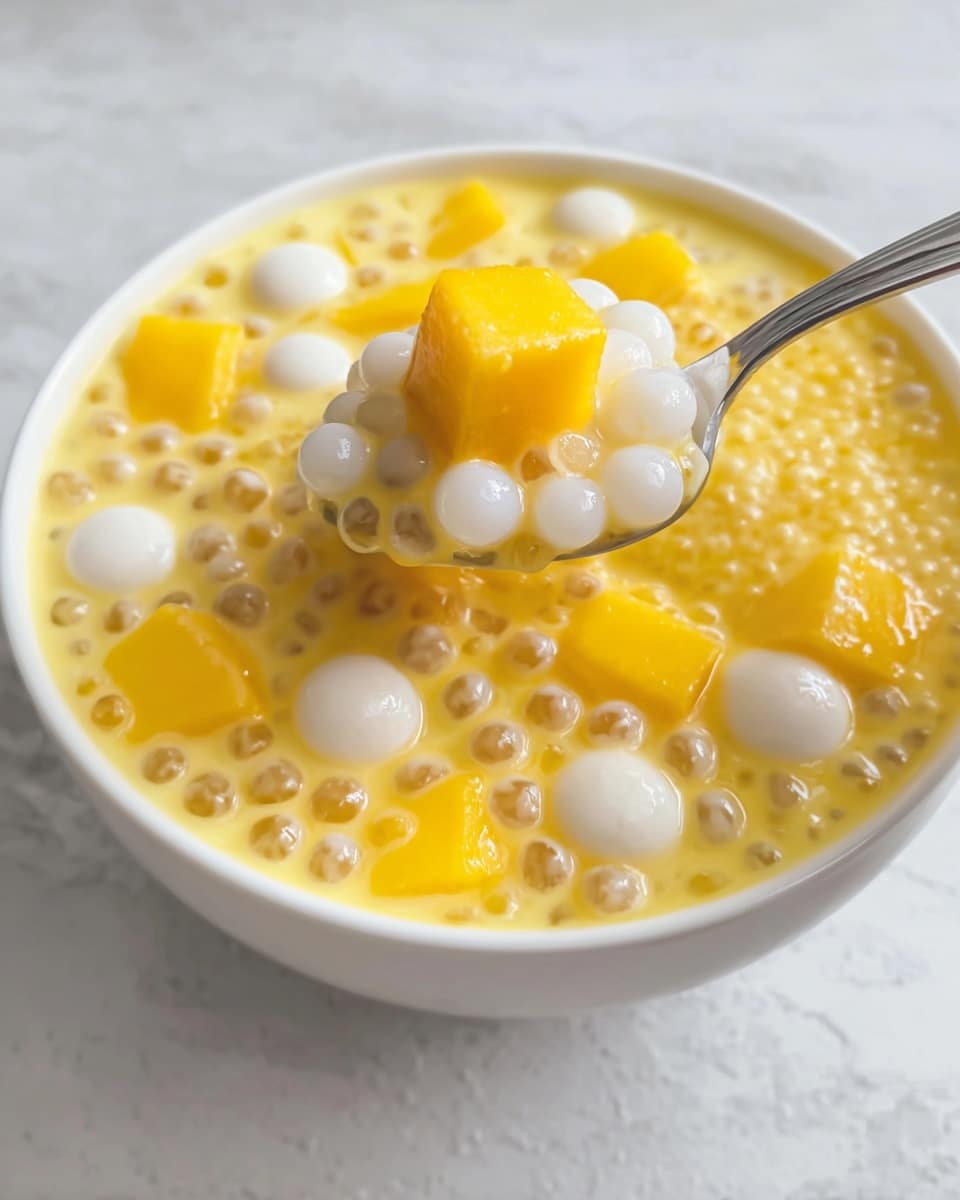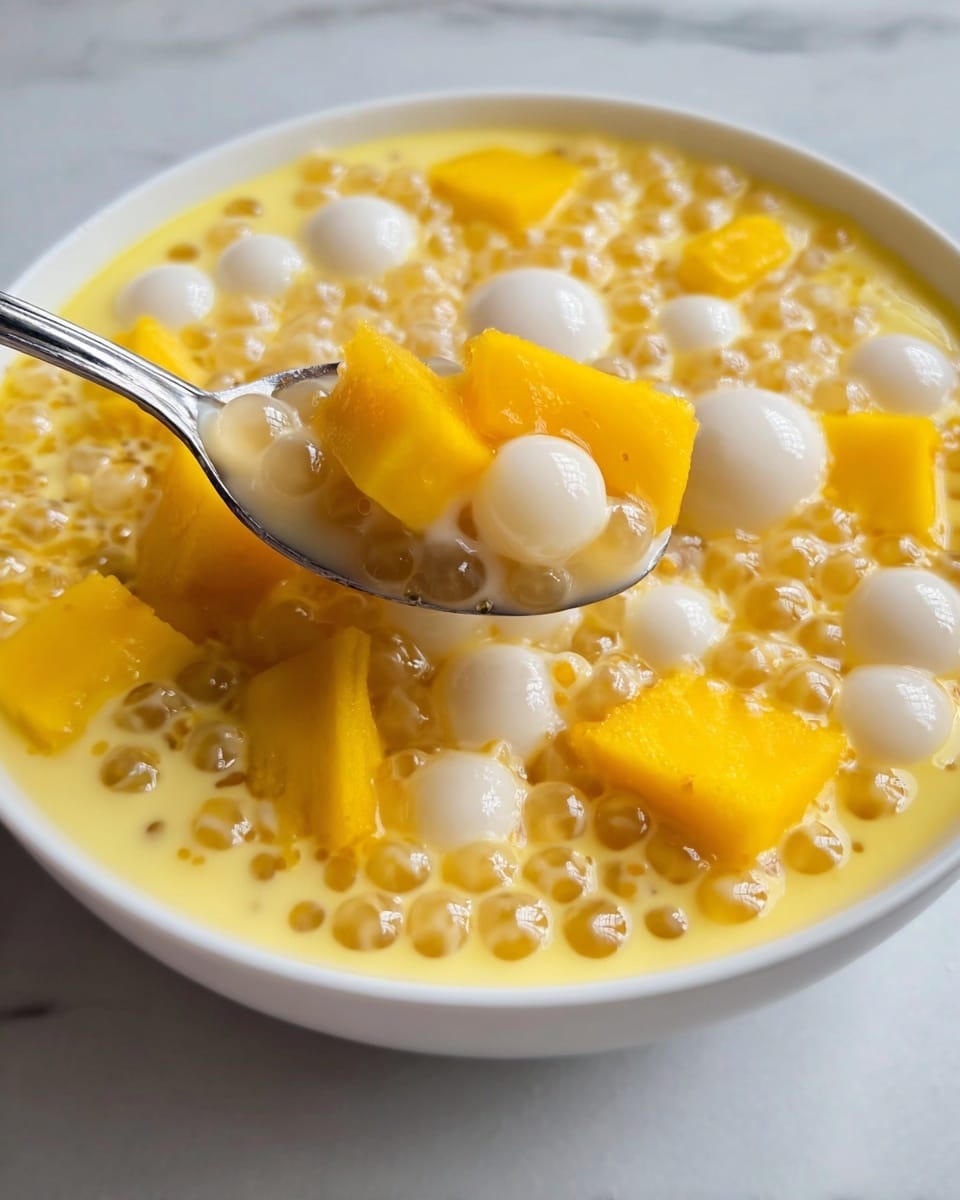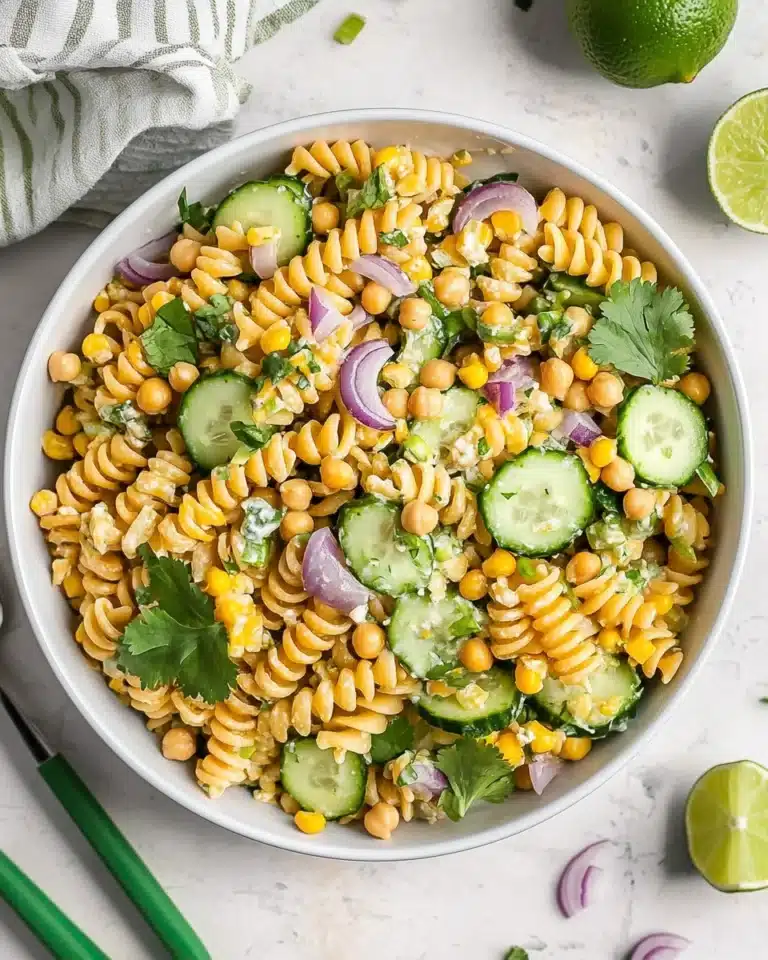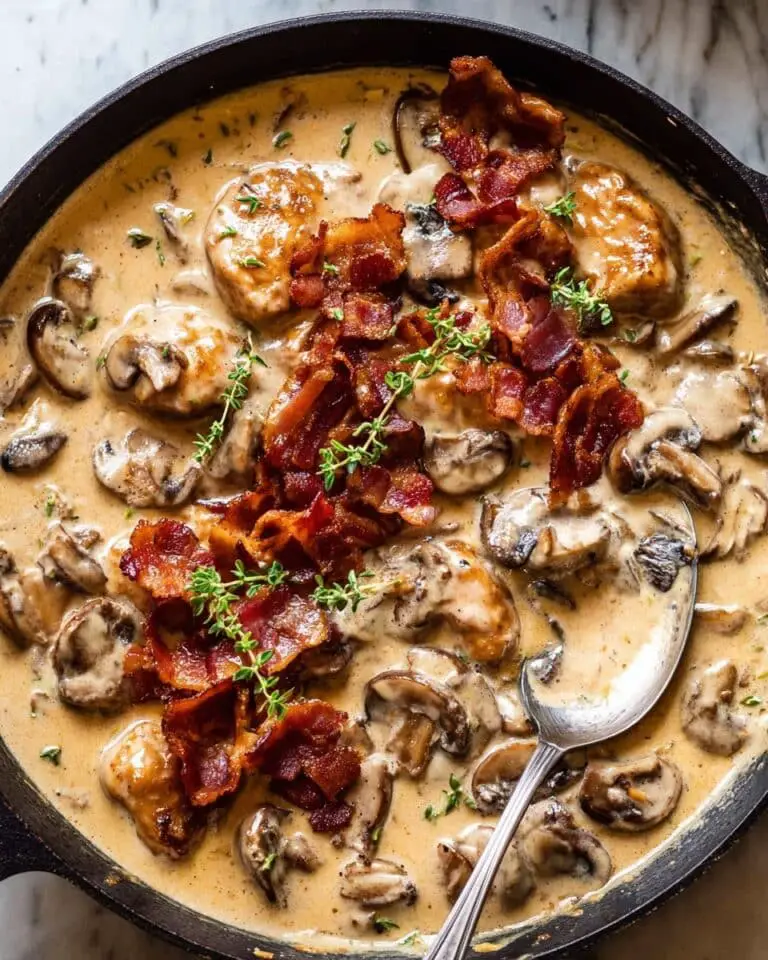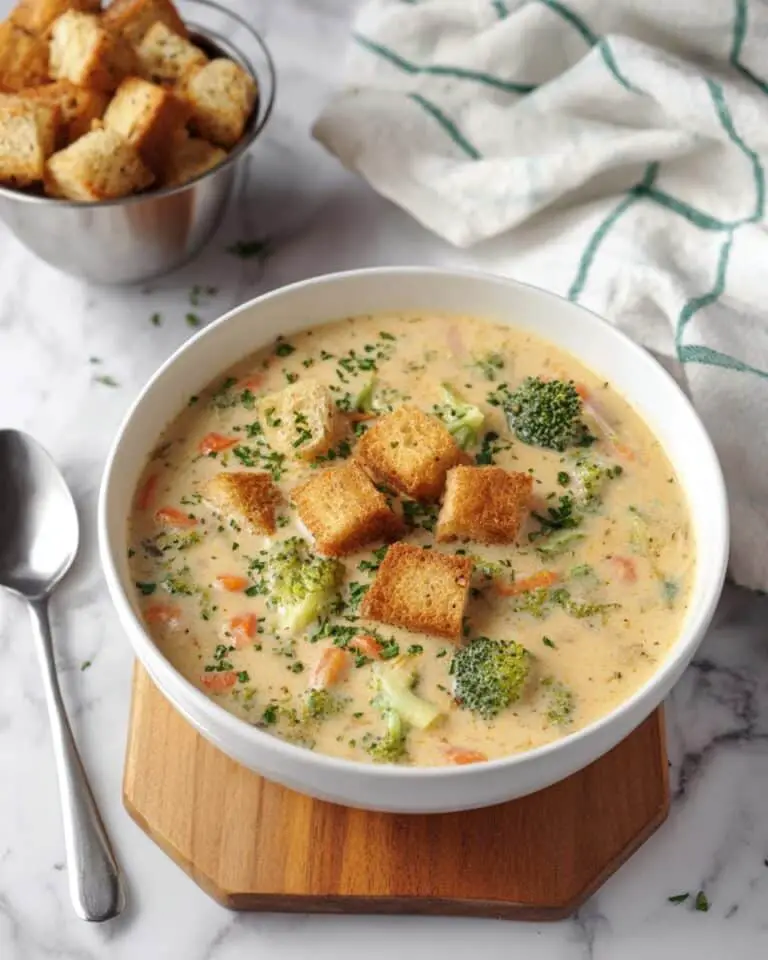If you’re craving something tropical, comforting, and a little bit playful, this Mango Sticky Rice Recipe will quickly become your new favorite treat. I absolutely love how this version combines luscious fresh mango with chewy little sticky rice balls and the pearly texture of sago—it’s like a party in your mouth! It’s refreshing yet satisfying, and once you get the hang of making those tender sticky rice balls, you’ll find it surprisingly easy to whip up anytime.
Why You’ll Love This Recipe
- Iconic Flavor Combination: The classic mango and creamy coconut milk blend is every tropical lover’s dream come true.
- Fun Texture Play: Adding chewy sticky rice balls and sago brings delightful mouthfeel contrasts that keep each bite interesting.
- Simple Ingredients, Impressive Dessert: You’ll just need a handful of pantry staples and fresh mango for a fancy-looking treat.
- Customizable & Chill-Friendly: You can make this ahead and chill it for a refreshing dessert or snack anytime.
Ingredients You’ll Need
Each ingredient plays a key role here—from the creamy coconut milk that ties everything together to the glutinous rice balls that add that signature chewiness mango sticky rice is known for. I always recommend using ripe, juicy mangoes for the best flavor, and don’t skip the soaking step for your sticky rice balls—trust me on this one.
- Sago pearls: These tiny tapioca pearls bring a soft, slightly chewy texture that complements the sticky rice balls perfectly.
- Mango flesh: Choose a sweet, ripe mango for maximum flavor and natural sweetness.
- Coconut milk: Use full-fat coconut milk for that rich, creamy consistency that makes the dish sing.
- Glutinous rice balls: These small sticky rice balls are essential for that chewy bite that makes this recipe unique.
Variations
One of the things I love about this Mango Sticky Rice Recipe is that it’s so easy to tweak to your taste or what you have on hand. Sometimes I like to blend some mango directly into the coconut milk for a smoother, more luscious sauce, while other times I leave the mango diced for a fresh bite.
- Use frozen mango: I’ve done this when fresh mangoes weren’t in season, and it works great if you thaw them properly before using.
- Add a pinch of salt to coconut milk: A little sting of salt balances the sweetness beautifully—this trick always surprised my family.
- Swap sago with tapioca pearls: If sago is hard to find, small tapioca pearls work fine and give similar results.
- Make it vegan: This recipe is naturally dairy-free, but just double-check your glutinous rice balls don’t have any added non-vegan ingredients.
How to Make Mango Sticky Rice Recipe
Step 1: Cook the Sago Pearls to Perfection
Start by boiling a large pot of water—the ratio of water to sago should be at least 10:1 because sago absorbs a lot of water. Once the water is rolling, add in your sago pearls and give it a gentle stir so they don’t stick to the bottom. Cover the pot and let it simmer for about 20 minutes. You’ll know they’re almost done when you spot tiny white dots in their centers—this is helpful because overcooking will make them mushy, and undercooking leaves a hard center. Then, just turn off the heat, cover, and let them sit for another 20 minutes so they finish cooking gently in the residual heat. Drain and rinse the sago under cold water to stop the cooking process and keep them from clumping. I like to keep them in a bowl of cool water until I’m ready to assemble.
Step 2: Boil the Glutinous Rice Balls (Tang Yuan)
In a separate pot, bring water to a boil and add your sticky rice balls. Give them a gentle stir right away so they don’t stick together or to the pot. Once they float to the surface, let them simmer for an extra minute to make sure they’re fully cooked through. Remove them quickly and place them in bowl of cold water to prevent sticking and preserve their chewy texture. Pro tip: don’t overcook these or they’ll become gummy, and never skip the cold water bath after draining!
Step 3: Prepare Your Mango
Pick a ripe mango that’s fragrant and slightly soft. Peel and dice half of the mango into bite-size pieces—this will give you those fresh juicy chunks in every spoonful. For the other half, I like to mash it or blend it with the coconut milk for a silky smooth mango sauce that ties everything together. If you have a blender, it literally takes two minutes, but you can also mash by hand for a chunkier, rustic feel.
Step 4: Assemble and Chill
Now comes the fun part. In a serving bowl, layer your cooked sago pearls, the chewy sticky rice balls, and the diced mango pieces. Pour over the coconut milk and mango puree, then give it a gentle stir to combine everything. I usually like to make this a few hours ahead and pop it in the fridge—the flavors meld and it turns into a refreshingly cool dessert that’s perfect any time of day.
Pro Tips for Making Mango Sticky Rice Recipe
- Watch Your Sago Timing: Sago pearls cook quickly but can easily turn gluey if overdone—set a timer and do the water test to get it just right.
- Cold Water Bath Trick: Rinsing the cooked sago and sticky rice balls in cold water stops further cooking and keeps them chewy and separate.
- Blend Mango & Coconut Milk: Blending half the mango with coconut milk makes the sauce extra creamy and flavorful—give it a whirl if you want a silky finish.
- Don’t Skip the Chill: Serving this dessert cold not only tastes better but also thickens the coconut milk sauce naturally for more body.
How to Serve Mango Sticky Rice Recipe
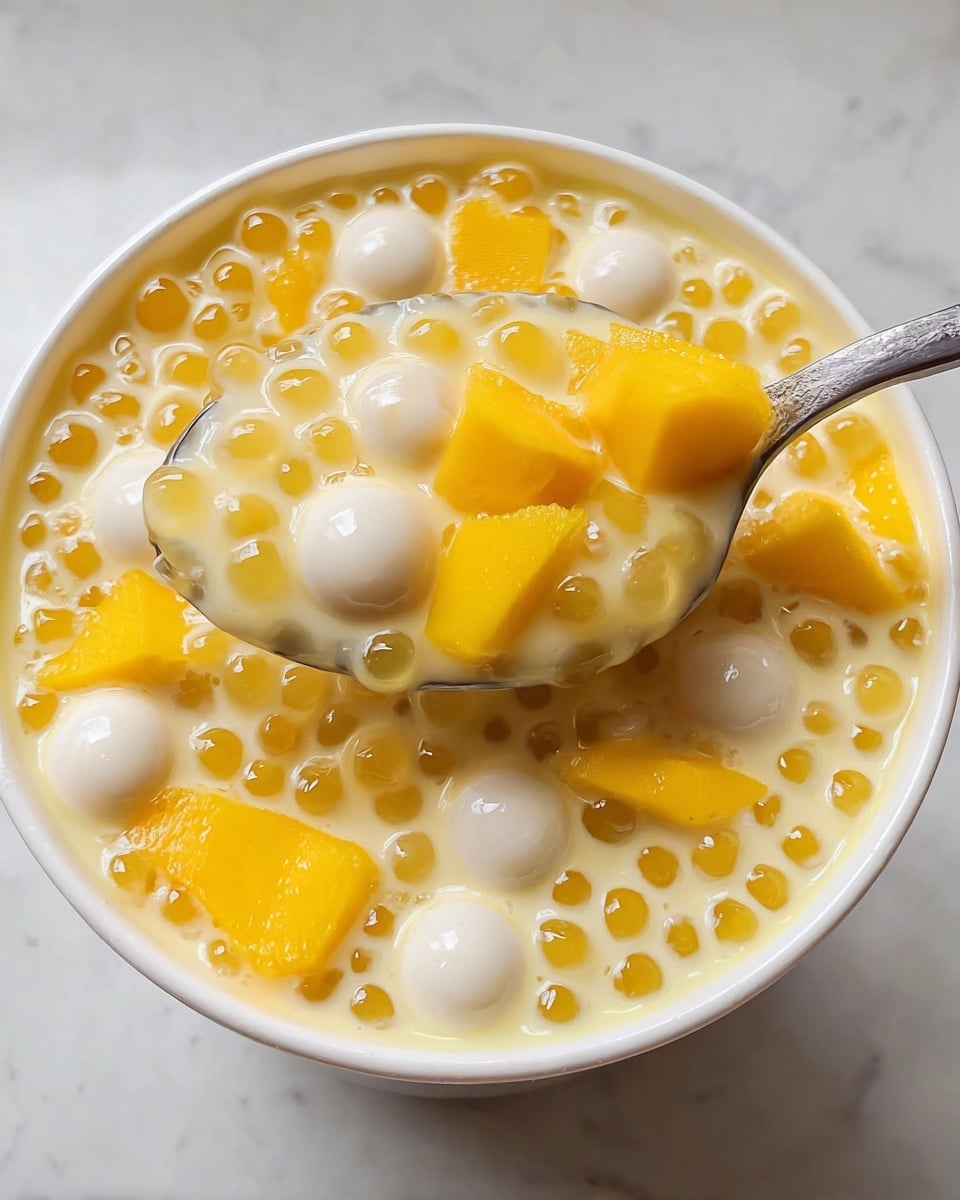
Garnishes
I like topping mine with a sprinkle of toasted sesame seeds or a few crushed roasted peanuts for a subtle crunch that contrasts beautifully with the creaminess. Sometimes, if I’m feeling fancy, I’ll drizzle a little coconut cream on top for extra richness and visual appeal. Fresh mint leaves can add a lovely pop of color and a hint of freshness as well.
Side Dishes
While this is often enjoyed as a standalone dessert, I’ve paired mango sticky rice with light Thai snacks like coconut custard or pandan jelly for a sweet Thai-themed afternoon tea. It also makes a perfect finish after spicy meals where you want something cool and soothing.
Creative Ways to Present
For special occasions, I’ve tried serving this in individual glass jars layered with mango puree, sticky rice balls, and coconut milk topped with edible flowers or gold leaf for a wow factor. You can also mold the sticky rice balls and sago into fun shapes with silicone molds for little festive bites. It’s a guaranteed crowd-pleaser!
Make Ahead and Storage
Storing Leftovers
I usually store leftover mango sticky rice in an airtight container in the fridge for up to two days. Keep the sticky rice balls and sago submerged in some coconut milk or a touch of water to prevent them from drying out. I’ve noticed they hold up well if you plan to enjoy them within a day or two.
Freezing
This isn’t the best candidate for freezing because the texture of the sticky rice balls and sago can become mushy and unpleasantly chewy once thawed. I recommend making just enough to enjoy fresh or refrigerate for a short time.
Reheating
When reheating, I gently warm the coconut milk and mango mixture on the stove or microwave, then stir it into the sticky rice and sago. However, I prefer this dessert chilled, so reheating is usually just a matter of bringing everything to room temperature or enjoying cold straight from the fridge.
FAQs
-
Can I use canned mango for this Mango Sticky Rice Recipe?
You can, but fresh ripe mango will always give you the best flavor and texture. If you use canned mango, check that it’s not packed in heavy syrup to avoid overly sweet or watery results.
-
What if I can’t find glutinous rice balls?
If you can’t find ready-made sticky rice balls, you could try making your own with glutinous rice flour, or substitute small tapioca pearls for a similar chewy effect, though the texture will be slightly different.
-
Is this Mango Sticky Rice Recipe vegan-friendly?
Yes! This recipe is naturally dairy-free and vegan as long as your sticky rice balls don’t contain any animal-derived ingredients. Coconut milk is plant-based and mango is, of course, fruit-perfect for vegan diets.
-
How sweet is this dessert?
This dessert relies mainly on the natural sweetness of mango and the richness of coconut milk, so it’s pleasantly sweet but not overpowering. You can always adjust by adding a touch of sugar or palm sugar to the coconut milk if you prefer it sweeter.
Final Thoughts
I absolutely adore this Mango Sticky Rice Recipe because it’s a vibrant, comforting dessert that instantly transports me to sunny days and warm smiles. Whether you’re treating yourself on a hot afternoon or sharing with friends who love something a bit different, it never disappoints. Give it a try—you’ll be amazed how simple ingredients come together into such a beautiful, joyful bowl of happiness. I can’t wait to hear what you think!
Print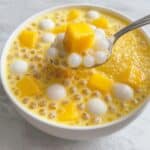
Mango Sticky Rice Recipe
- Prep Time: 10 minutes
- Cook Time: 25 minutes
- Total Time: 35 minutes
- Yield: 2 servings
- Category: Dessert
- Method: Stovetop
- Cuisine: Thai
- Diet: Vegetarian
Description
A refreshing Mango Smoothie with Small Sticky Rice Balls combines creamy coconut milk, sweet mango puree, chewy glutinous rice balls, and translucent sago pearls. This tropical dessert smoothie is perfect chilled and offers a delightful textural contrast and natural sweetness.
Ingredients
Sago
- 100 g sago pearls
- Water (over 10 times the weight of sago, for boiling)
Glutinous Rice Balls (Tang Yuan)
- 150 g glutinous rice balls
- Water for boiling
Mango and Coconut Milk
- 100 g mango flesh (approximately 1 medium mango)
- 240 g coconut milk
Instructions
- Cook the Sago: Boil a large pot of water, ensuring the water to sago ratio is greater than 10:1. Add the sago pearls once boiling, stir occasionally to avoid sticking, then cover and let it simmer for 20 minutes. When you notice small white dots in the center of the pearls, turn off the heat. Cover and let sit for an additional 20 minutes until the sago turns transparent. Scoop the sago out and rinse it in a bowl of water to prevent clumping.
- Boil the Glutinous Rice Balls: In another pot, bring water to a boil. Add the glutinous rice balls and gently stir to prevent sticking. Cook until the balls float to the surface, then simmer for 1 more minute. Remove them and transfer to a bowl of water to keep from sticking.
- Prepare the Mango: Dice the mango. Mash half of it by hand or blend it with the coconut milk for a smoother consistency.
- Assemble the Smoothie: In serving bowls, combine the cooked sago, diced mango pieces, and the glutinous rice balls. Pour in the coconut milk along with the blended mango puree. Stir everything thoroughly. For best results, chill the mixture in the refrigerator for a few hours before serving.
Notes
- Use plenty of water when cooking sago to prevent them from clumping or sticking to the pot.
- Rinsing the cooked sago and rice balls in cold water stops the cooking process and keeps them from sticking together.
- Blending half the mango with coconut milk creates a smooth, creamy base while the diced mango pieces add texture.
- This dessert is best served chilled for a refreshing treat.
- You can adjust the coconut milk quantity to achieve desired creaminess.
Nutrition
- Serving Size: 1 serving
- Calories: 320 kcal
- Sugar: 18 g
- Sodium: 15 mg
- Fat: 18 g
- Saturated Fat: 16 g
- Unsaturated Fat: 2 g
- Trans Fat: 0 g
- Carbohydrates: 35 g
- Fiber: 2 g
- Protein: 3 g
- Cholesterol: 0 mg

